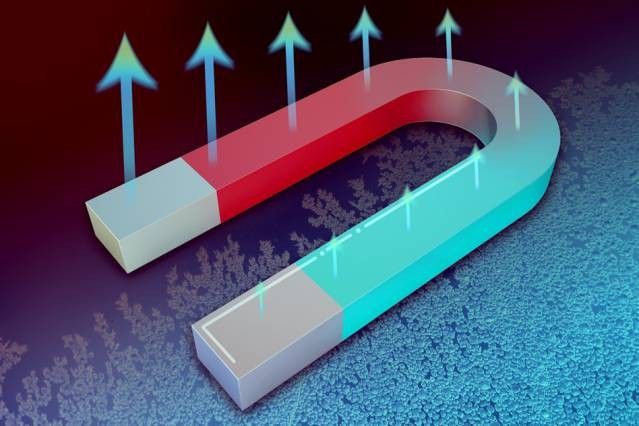Dongguan Magnetoelectronics Technology Co. Ltd..
Contact: Miss Zhang
Tel: 0769-22336260
Mailbox: 3468754465@qq.com
Website: www.magpresee.com
Address: Room 102,No.7 Xingye Road,Low Chung,Gaobu Town,Guangdong,Dongguan City,Guangdong province
According to a new theory put forward by researchers at the Massachusetts Institute of Technology, magnets stuck on the surface of refrigerators could one day be used as coolants, the Science Daily reported on August 1 in Beijing. This theory describes the movement of magnets. Magnets are quasi particles of magnets. They are the collective rotation of magnetic moments, or "rotation." In addition to the magnetic moments, the magnets can also conduct heat. Using the equations they proposed, MIT researchers found that when exposed to magnetic gradient, the magnets may transfer from one end of the magnet to the other, carrying heat and producing cooling effects.

最新理论预测磁铁可以作为无线冷却剂
"You can pump heat from one end to the other, so you can essentially use magnets as refrigerators," says Liaobailin, a graduate student at the Massachusetts Institute of Technology's School of Mechanical Engineering. "You can imagine the application of wireless cooling, such as adding a magnetic field to a computer at a distance of one or two meters to cool the computer. "
In theory, this magnetically driven refrigerator does not need to move parts. Unlike traditional refrigerators, the latter needs to extract fluids through a series of tubes to cool down. Liaohe, another graduate student, Zhoujiawei, and Liaohe, Dean of the MIT Institute of Mechanical Engineering, published these articles on the theory of magneton cooling in the journal Physical Review Express.
"Now people have a new theory to study how magnets move under co-storage fields and temperature gradients," Liao said. "These equations are fundamental to magneton transmission. "
Cooling effect
In a ferromagnetic material, the local magnetic moment can be rotated and aligned in different directions. At absolute zero, the local magnetic moment will be aligned to produce the strongest magnetic force in the magnet. As the temperature gradually rises, the magnet becomes weaker and weaker, because more and more local magnetic moments rotate away from the alignment line, and the gradually rising temperature produces a magnetic subset.
Magnets are similar to electrons in many ways. They are charged and conduct heat. Electrons respond to electric fields or temperature gradients -- a phenomenon known as the thermoelectric effect. In recent years, scientists have investigated various applications of this effect, such as thermoelectric generators, which can convert heat directly into electricity or achieve cooling effects without moving any components.
Liaohe and his colleagues identified a similar "coupling" effect in the magnet that responds to two forces: temperature gradients or magnetic fields. Because the behavior of magnets and electrons in this area is very similar, the researchers proposed the theory of magneton transfer based on the Pozman transfer equation, which is widely accepted in thermoelectricity.
According to the derivation of this equation, Liao, Zhou, and Chen proposed two new equations that describe magnetic transport. Using these new equations, they predicted a new magneton cooling effect, similar to the thermoelectric cooling effect, that is, the magnet carries heat from one section of the magnet to the other under a magnetic field gradient.
Stimulate new experiments
Liao uses the characteristics of common magnetic field insulators to model how the magneton cooling effect works in existing magnetic field materials. He collected the data from the previous literature and then entered the data into the latest model. They found that the material can indeed produce a cooling effect on a moderate magnetic field gradient. Although this effect is very small, this effect is very significant at low temperatures.
Theoretical results show that the first applications of the magneton cooling effect may help scientists in projects that require wireless cooling at ultra-low temperatures. "At this stage, the potential application is Cryogenics -- for example, cooling infrared detectors," Chen said. "However, we still need to experimentally prove this effect and find better materials. We hope this will encourage new experiments. "
Li Shi, a professor of mechanical engineering at the University of Texas at Austin, said that the magnetic field cooling effect identified by the team is "an extremely useful theoretical framework for studying the coupling between rotation and heat. It can potentially stimulate the concept of using magnets as working 'fluids' in solid-state refrigeration systems. Shi did not participate in this study.
Liao pointed out that magnets can also be a new tool for improving existing thermoelectric engines. Although this ability to use thermal power generation is very innovative, it is still relatively inefficient. "Thermoelectricity has a long way to go to compete with traditional technology," Liao said. "Studying magnetic field degrees of freedom can potentially optimize existing systems and improve thermoelectric efficiency. "
